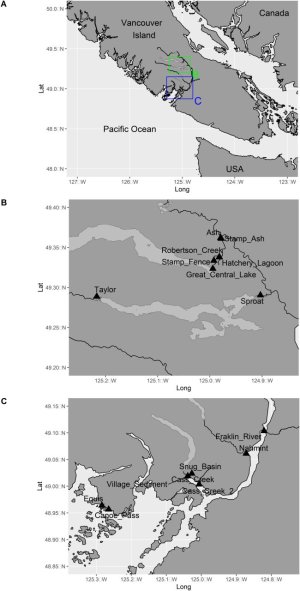Figured you'd be interested, Nog. Concerning stuff. More concerns:
1/ They found 2 viruses, Cutthroat trout virus-2 (ctv-2), which is associated with brain lesions, and Erythrocytic necrosis virus (env), that infects blood cells, were only detected in the hatchery effluent. env was purportedly a marine virus but now found here in FW;
2/ The bacterium Flavobacterium psychrophilum (fl_psy), the causative agent of bacterial coldwater disease (BCWD), was detected in all samples
(including at low levels in the control), but was at highest levels below the Cermaq facility. It can be problematic in juvenile fish in freshwater environments and is well known among hatcheries for causing “bacterial coldwater disease” which can be lethal,
3/ Ichthyophonus hoferi (ic_hof) , a common vertically transmitted marine parasite of fish, was only detected in the effluent from Boot Lagoon. It is well known to impact Chinook salmon migrating in the Yukon River,
4/ Kudoa thyrsites (ku_thy), a parasite of diverse marine fish species, was only detected in and downstream of the Boot Lagoon effluent,
5/ Renibacterium salmoninarum (re_sal), the causative agent of BKD, was detected in the Boot Lagoon effluent and at lower levels in the Stamp River before its confluence with the Ash,
6/ Yersinia ruckeri (ye_ruc), that causes enteric redmouth disease, was detected in the Boot Lagoon effluent as well as at the Stamp before the Ash confluence,
7/ Vibrio anguillarum (vi_ang) and Vibrio salmonicida (vi_sal), that can both cause vibriosis or Hitra disease, were detected exclusively in the effluent of the Boot Lagoon facility. Listonella (Vibrio) anguillarum causes vibriosis, a hemorrhagic septicaemic disease affecting salmonids in salt and brackish water, particularly in the summer months when the water temperature rises above 10C. Aliivibrio (Vibrio) salmonicida is the causal agent of cold water vibriosis (also known as Hitra disease), a septicaemic condition affecting primarily farmed Atlantic salmon and rainbow trout in saltwater,
8/ The Stamp River showed increased infectious agent loads downstream of the Boot Lagoon effluent (Downstream of Fence, and Stamp at Ash), compared to samples that did not directly contain aquaculture effluent (Ash and Great Central Lake).



